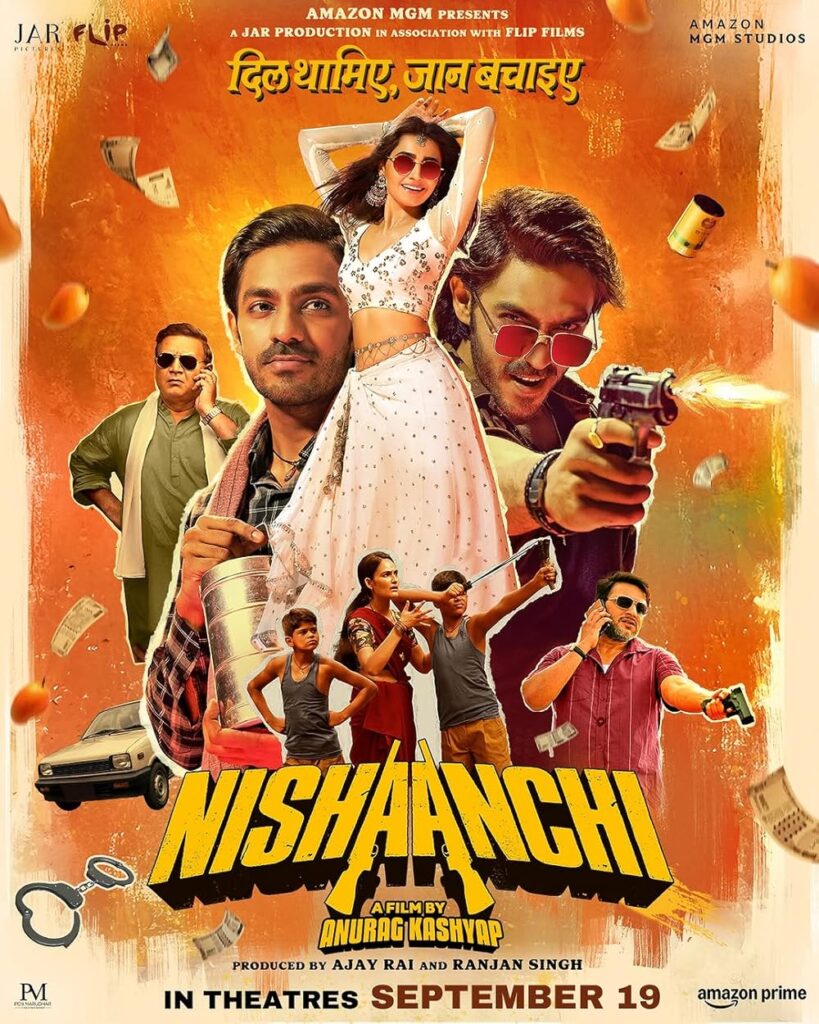Nishaanchi
Introduction
The politics in the new Hindi film Nishaanchi starts from its first shot when a random shot of the road is accompanied by the sound of the Azaan followed by the sound of bells of a temple. It is Anurag Kashyap’s style of indicating the united world that we were once used to, even as a caption reads the year 2006 (a straight up dig at that ‘someone’ in power). The city this time is Kanpur, which is essentially used as a character for crime, much like Wasseypur was used in the cult Anurag Kashyap film Gangs Of Wasseypur (2012). Immediately you know that the impeccable filmmaker is in form – something that is further accentuated in a cold open wherein you see a character reading out a threat from a handwritten paper with a gun in his hand, only for the other character (who is at the receiving end of the barrel), pause…pull out his spectacles and fill in for the mumbling culprit. It is vintage Anurag that brings back all the memories of the unhinged humour that was once his staple diet in even some of his most dark films!
Story & Screenplay
Written by Anurag Kashyap, Ranjan Chandel and Prasoon Mishra, the characterization remains an integral part of Nishaanchi, that deftly follows a Gangs Of Wasseypur template. This template has an extended flashback, some zany characters, multiple conflicts and dynamics in play and a fetish for the second part (yes, you read that right). And the indication of the same is given by the song ‘6 ghante ki Picture shuru hai’, that effectively briefs you about the duration of this film as well (Part 1 is 3 hours long). The cold open does enough to establish the principal characters – Babloo aka Tony (Aaishvary Thackeray) who loves calling himself as Tony Mantena, a direct reference to the character of Al Pacino in Scarface (he interestingly also has a scar on his face😂), is a small time boorish goon who is shown to try and rob a bank but instead is caught in the process. The humour in the scene originates from the time he tries to enter – being stopped by a bank guard who warms up to him only to be shot in the leg, even as chaos ensues following which Babloo is hilariously caught.
The other side of the same coin remains Dabloo (also Aaishvary Thackeray), Babloo’s twin brother who is more sedate and reserved as opposed to the flamboyance of his brother. It is almost as if Dabloo suffers from an anti-Ranbir Kapoor syndrome from Bachna Ae Haseeno (2008) wherein he goes into a shell with females around. And hence that is what makes the character of Rinku (Vedika Pinto) interesting. She is essentially a Kathak dancer who switches to the other side of the brothel after her father’s death while having an affair with Babloo. But with Babloo now behind bars, her close proximity to Dabloo cannot be denied as well, in a drama that is quick to ‘imply’ this conflict.
The Ramadheer of this tale is Ambika Prasad (Kumud Mishra), a vily old fox who doubles up as the land mafia, threatening people to allocate their land for redevelopment (and needless to say that he gets his cut too). This is a hint of politics with respect to autocracy and capitalism in play that laces the narrative, even whilst deliberately being played out in the fringes. But interestingly unlike Sardar Khan who is always pitted against Ramadheer Singh from Gangs Of Wasseypur, you see Babloo being a part of Ambika’s gang, despite the fact that the latter shares a long history of vile and revenge as far as Babloo’s family comprising of his mother Manjari (Monika Panwar) is concerned. Manjari is a woman of substance, almost single-handedly bringing up her two children, teaching Babloo to aim correctly on the mango tree (a symbolism of restraint as far as her life is concerned, also how Babloo got the term ‘Nishaanchi’), something that also stems from the fact that she was a double-trap shooter too – admittedly saying ‘chidiya ke g@@nd pe goli maarti hun’ to a younger Ambika.
In all of it, you can sense a revenge saga buried in somewhere, particularly with respect to the character of Jabardast (Vineet Kumar Singh), who is at the receiving end of the politics in the vicinity. Jabardast is a wrestler himself, often found to be out of favour for another candidate who is known to pull strings for his benefits. It is fitting on how a song titled ‘I Love My Country’ is sandwiched between this incident of hopelessness for Jabardast, while invariably focusing on the potholes on the roads. It is a perfect integration of politics that tells you a story or two about the state of the nation (the time period is said to be the late 90s in this passage), while almost coaxing the viewers to reflect on the state of affairs today.
Two independently important dynamics are in play parallelly – one involving Manjari’s vent towards a younger Ambika who has fallen head over heels for her. This equation extends on the current timeline too, even as she firmly asserts him to stay away from her family. The second equation is more of a love triangle that erupts between Babloo, Rinku and Dabloo – with the former couple sharing a warm bond filled with ‘hormones’ even as Rinku is unaware of a specific deed with respect to Babloo. And whilst Babloo is away in jail, her close proximity with Dabloo cannot be ignored too.
The entire narrative of this film is dedicated to the world building and characterization which was a little unlike Gangs Of Wasseypur that was mounted on a single conflict – that of revenge. The revenge angle is only deftly in play given how the exposition of many characters remains hidden to the stakeholders of this world. There are minor touches of brilliance even with respect to the playful kills or a budding love story that forces Babloo to learn about hormones and the circulatory system. It is hilarious but also marks a comeback of the typical Anurag Kashyap humour that was largely missing in his previous few outings.
That said, the drama isn’t without its flaws here – the runtime of nearly 3 hours is quite punishing particularly in the second hour that meanders its way through moments of brilliance. It wouldn’t be wrong to say that the events are mildly repetitive, even when the character dynamics are established, and that isn’t ideal in the narrative. I am also not a fan of a flashback within a flashback, something that you witness in an important scene at the halfway mark that suddenly cuts away into the past. The emotional moment was there for the taking and you didn’t really need to cut away to establish it further.
But the most important flaw for me was the payoff at the end – something that need not have been so obvious. You remember the ending of Gangs of Wasseypur part 1, and how a bullet-ridden Sardar Khan emerges from his vehicle only to collapse with ‘Jeeye Ho Bihar Ke Lala’ playing in the background? It setup things for an explosive second part brilliantly. Comparatively, the ending is timid with an existing conflict doubling up as an exposition. Imagine if that character had known this all along – and the dynamics that would then be setup for the second part. That wasn’t to be in a screenplay that I liked but honestly I wanted to like it even more.
Dialogues, Music & Direction
The dialogues are authentic with the place that the drama is set in while laced with an inherent sense of humour that is at this point an Anurag Kashyap trademark of sorts. There are film references to be deciphered by cinephiles (one of them being Scarface), even as Babloo goes on a spree retelling his rehashed version of the film, reimagining himself to be the protagonist (and similar to how we all felt while walking out of a cinema hall at some point). It is a montage that doubles up as a relatable moment for cinephiles like me.
It wouldn’t be wrong to say that Nishaanchi is a musical, with music playing an integral part in the narrative. The varied themes of the narrative with respect to the film itself, or the politics in play or just establishing the colourful world of Kanpur, is ably enhanced through the songs that add texture and substance to the narrative. And when you have characters all decked up in an Anurag Kashyal film during a ‘still’ music sequence – you just know that it adds to the humour of the film. The cinematography is delightful wherein the camerawork of atleast two action set-pieces stands out. In a scene, you see a jail fight sequence involving Babloo that uses the StoriCam to great effect, placing it on his back and capturing the action ably. In another, the use of drones in a small little passage makes for a notable innovation set-piece that explodes like a time bomb just the way it should. And I cannot stress how authentic the setting looks just because the filmmaker chooses to shoot his film in real locations, something that makes the setting an important character in the mix too.
The editing by Aarti Bajaj is a little too indulgent, particularly in the second hour that feels like a collection of shots put together. The transition from one scene to another isn’t as smooth, even while not quite accounting for the lags in the narrative. I wouldn’t completely be dismissive of it but a little more continuity and crispness wouldn’t have hurt the film. Director Anurag Kashyap showcases glimpses of his brilliance in certain scenes, but let’s face it – it is virtually impossible to recreate the brilliance of Gangs Of Wasseypur in every Anurag Kashyap outing. Nevertheless, he takes his time in establishing the world and the characters that contribute to the vibrancy of the drama. Sure, your argument could be that the characters aren’t as memorable as the ones in GoW, but you still feel a sense of playfulness when they appear onscreen. In fact, Anurag accounts for multiple moods in the drama seamlessly, shifting from comedy to drama and emotions with ease. The direction remains pretty solid here with a touch of his trademark humour that invariably adds freshness to the drama even whilst it stretches in the second hour.
Performances
The performances are delightful by the members of the cast even though all characters aren’t as memorable as the ones in GoW. Having said that, I can totally imagine a handful of these characters making their way to meme culture in the near future. Also, tell me if you did spot a famous Malayalam director right at the start in a scene from the film too (I shall keep this information under wraps😀). Durgesh Kumar as the bank security guard and Ghanshyam Garg as the bank manager are downright hilarious despite a limited screentime while making their presence felt, wonderfully so. Gaurav Singh as Pankaj, Jaskaran Singh Gandhi as Pehalwan, Murari Kumar as Baba Lasan (omg, I died laughing here), Prateek Pachauri as Phlunky, Sahaarah Shukla as Puraane and Shubham Tiwari as Hawa Hawai are an interesting bunch of characters that are quite amusing to witness.
Viineet Kumar Singh who is in the middle of a purple patch in 2025, shines as Jabardast – bringing a lot of stillness and intensity to his character that makes you emotionally connected to him. He owns the scene in the interval block wherein he is subjected to varied emotions in the same moment. Rajesh Kumar as Bhola Pehalwan adds to the texture of the drama wonderfully well, while making his presence felt in the drama. In fact, a particular scene involving him is so well staged that it invariably contributes to the dark humour in the narrative. And so glad to see him getting roles outside his ‘Rosesh’ zone, something that was threatening to stereotype the performer in him. He is excellent to witness here despite a limited screen time.
Mohd Zeeshan Ayyub as Kamal is another actor that owns the arena in an early scene that features him. He is playful and a delight to watch here, while being effortless with his craft. When the need is to remain dignified, he does so wonderfully, and otherwise he indulges in a playful banter brilliantly so. Girish Sharma as the younger version of Ambika is a revelation. You can sense the early forms of ambition and vile that is mixed with cunningness at the start of his arc, and Girish uses his expressions and body language to great effect here. He is excellent in a performance that may well be the best of his budding career so far, and it is fast turning out to be a great 2025 for him after a solid outing in The Hunt.
Kumud Mishra as Ambika is vile and scheming, a direct extension to his budding form essayed by Girish Sharma. He remains intimidating and understated but you do witness the vulnerability in his character when challenged by Manjari. He is effective in communicating the perverse in his character, and dare I say that his character will be the one to look forward to in the next part. Vedika Pinto as Rinku has a radiating screen presence, while managing to tap into all the right emotions with respect to her character. She is unhinged with respect to the humour and affection that her character possesses whilst also becoming an important cog in the next part, given how things are currently placed. This may well be a career defining performance wherein she charms you while being natural to the core onscreen.
Monika Panwar has to be one of the most talented bunch of actors doing the rounds currently. And like her brilliant outing in the Amazon Prime show Khauf (2025), she excels as Manjari here too – in a character that is Richa Chadha-coded from GoW. She is understated but assertive, almost being well aware of the politics around her that resulted in a tragedy for her family. She is cautious with guile but also righteous (thus far), thereby putting forth a commendable act that will only explode even more in the next part.
Aaishvary Thackeray is a revelation here, excelling in both the roles of Babloo and Dabloo (also, can we take a moment to praise the brilliant VFX of the film wherein a seamless shot involves both characters sitting next to each other, also…also, Sinners (2025) who?). As Babloo he is fiery but also playful, heavily referencing his antics to Tony Montena from Scarface (1983). And as Dabloo, he is understated and an introvert, restricting his movement and coming across as affable. Aaishvary uses his body language and expressions to great use, creating a contrast that would genuinely make it hard to think that both these characters are played by the same actor. This remains a super impressive debut, something that accounts for multiple moments of brilliance along the way.
Conclusion
Nishaanchi is an engrossing drama backed by incredible performances and a trademark Anurag Kashyap touch of magic, that makes for a solid watch. But having said that, I wanted to like it a little more than I ended up doing, particularly due to a few moments of lag and a timid payoff at the end. Still, this is fun while it lasts, and I will take this outing anyday. Available in a theatre near you.





